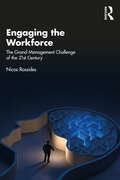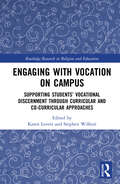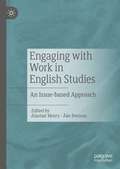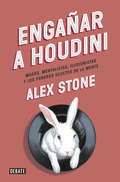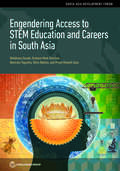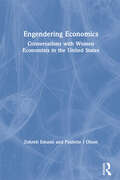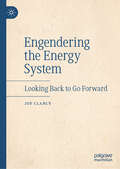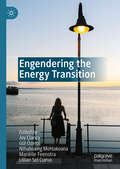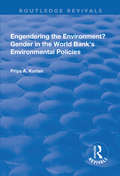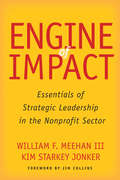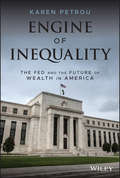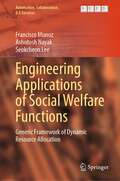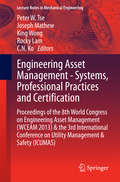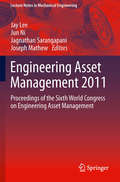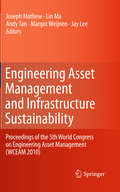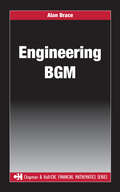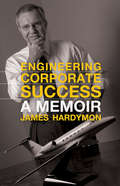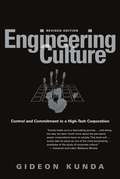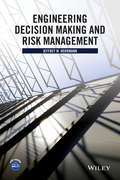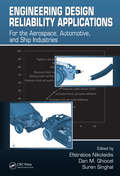- Table View
- List View
Engaging the Workforce: The Grand Management Challenge of the 21st Century
by Nicos RossidesGrounded in 25 years of research and practical experience, this book shows how to create engaging work environments and practices that harness employees’ energy and talents toward achieving organizational goals, while enhancing workers’ motivation and well-being. Creating and sustaining high functioning work environments lies at the core of management practice, and employee engagement is a key element in shaping these workplaces – and a significant challenge for business leaders. Academic researchers and practitioners have tackled the topic, but a chasm exists between these perspectives: academics tend to emphasize theory over problem-solving, while practitioners tend to rely on formulaic approaches and experience, rather than empirically tested theoretical frameworks. Thought leader, accomplished CEO, and organizational development consultant Nicos Rossides bridges this gap, exploring the complexity and fragmented nature of the academic literature and offering insight into practitioner approaches used by research and consulting organizations. He also presents his own conceptual framework that he has built over the years and is meant to be customized to specific organizational contexts. This insightful book will be of great interest to CEOs, board members and line managers across industries, as well as HR/OD practitioners and students, especially those who wish to learn how to apply time-tested intervention strategies to the workplace engagement challenge.
Engaging the Workforce: The Grand Management Challenge of the 21st Century
by Nicos RossidesGrounded in 25 years of research and practical experience, this book shows how to create engaging work environments and practices that harness employees’ energy and talents toward achieving organizational goals, while enhancing workers’ motivation and well-being.Creating and sustaining high functioning work environments lies at the core of management practice, and employee engagement is a key element in shaping these workplaces – and a significant challenge for business leaders. Academic researchers and practitioners have tackled the topic, but a chasm exists between these perspectives: academics tend to emphasize theory over problem-solving, while practitioners tend to rely on formulaic approaches and experience, rather than empirically tested theoretical frameworks. Thought leader, accomplished CEO, and organizational development consultant Nicos Rossides bridges this gap, exploring the complexity and fragmented nature of the academic literature and offering insight into practitioner approaches used by research and consulting organizations. He also presents his own conceptual framework that he has built over the years and is meant to be customized to specific organizational contexts.This insightful book will be of great interest to CEOs, board members and line managers across industries, as well as HR/OD practitioners and students, especially those who wish to learn how to apply time-tested intervention strategies to the workforce engagement challenge.
Engaging with Vocation on Campus: Supporting Students’ Vocational Discernment through Curricular and Co-Curricular Approaches (Routledge Research in Religion and Education)
by Karen Lovett and Stephen WilhoitBringing together narratives and theory-based analyses of practice, this volume illustrates collaborative curricular and co-curricular approaches to promoting vocational discernment amongst students in a Catholic university setting. Drawing on cultural, religious, and secular understandings of vocation, Engaging with Vocation on Campus illustrates how contemporary issues around vocation, work, and careers can be addressed within the Catholic intellectual and spiritual tradition. Chapters presents a range of contributions from students, faculty, and staff from a single institution to highlight practical approaches to supporting students in this area, and acknowledge the complementary and intersecting roles played by student support services, academic staff, and on-campus ministry in helping students develop an individualised understanding of vocation. Considering the value of both curricular or non-curricular activities and processes, the volume highlights spiritual, personal, and community value in offering students explicit and tailored support. This text will benefit researchers, academics, and educators with an interest in higher education, religious education, and the Christian life and experience more broadly. Those specifically interested in career guidance, theological curriculum and pedagogy, and Roman Catholicism will also benefit from this book.
Engaging with Work in English Studies: An Issue-based Approach
by Alastair Henry Åke PerssonThis edited book focuses on practices of work in late modern society, taking an ‘issue-based’ and interdisciplinary approach to English Studies which acknowledges the impact of globalization on the position of English in the daily existence of millions of people around the world. Envisioning English as “a diverse yet unified subject” where the study of literature, language, and education can be pursued thematically, it constitutes part of an ongoing transformation and revitalization of English Studies. It will be of interest to readers with backgrounds in linguistics, literature and education, as well as fields normally seen as lying ‘beyond’ English Studies such as psychology, sociology, philosophy, urban studies, political science and childhood studies.
Engañar a Houdini: Magos, mentalistas, ilusionistas y los poderes ocultos de la mente
by Alex StoneDesde los sótanos donde se reúnen los antiguos clubs de magia de Nueva York hasta los laboratorios de psicología más avanzados, de los trileros en las esquinas a los casinos más lujosos, Engañar a Houdini cuenta los esfuerzos de Alex Stone por entrar en el mundo de las maestros de la magia. A medida que se adentra en esta peculiar y a menudo hilarante subcultura, poblada por brillantes excéntricos, Stone nos muestra una comunidad que permanece en secreto, obsesiva y brillante, y organizada en torno a una necesidad imperiosa, probar la valía propia engañando a los demás. Pero el viaje de Stone es más que una historia de trucos, rutinas y loquitos. Al contemplar algunos de los rincones más olvidados de la psicología, la neurología, la física, la historia e incluso el crimen, Engañar a Houdini llega a sorprendentes conclusiones sobre cómo funciona la mente, y por qué, a veces, no lo hace."Engañar a Houdini es un viaje iluminador e irresistible al mundo de la magia. Stone ha escrito un libro magistral repleto de energía, creatividad y la sensación de asombro en cada página." Steven Levitt, autor de Freakonomics
Engendering Access to STEM Education and Careers in South Asia (South Asia Development Forum)
by Namrata Tognatta Shobhana Sosale Graham Mark Harrison NakataBuilding a skilled and diverse science, technology, engineering, and mathematics (STEM) workforce is crucial for economic development, cross-border trade, and social inclusion in South Asia. However, underrepresentation of girls and women in STEM education and careers remains a persistent issue. What kinds of macro and micro socioeconomic interventions are needed to increase girls' and women's access to and participation in STEM education and careers in South Asia? This book compares trends in South Asia with global trends to examine how access to and choices of STEM fields affect girls' enrollment in upper secondary education, technical and vocational education and training, and higher education in the region as well as their selection of careers. Based on the analysis, it offers recommendations to policy makers and practitioners to improve inclusion. The following are among the findings: (1) The five key opportunities to foster inclusion and enrollment in STEM education--and staunch the 'leaky pipeline'--are at the upper primary, lower and upper secondary, and tertiary education levels, and during the early career years; (2) A strong pathway from STEM education to career depends on an integrated, systematic approach that motivates students to pursue STEM fields, builds STEM skills, and removes barriers to diversity; (3) With the increasing migration of workers between countries in South Asia, preparing a critical mass of semiskilled and skilled STEM migrant workers has cross-border value, especially for workers migrating from smaller to larger economies. New ways of defining STEM occupations are required to help develop and sustain female interest in STEM education and careers. Potential strategies that governments can pursue include raising awareness and building knowledge and skills in STEM outside the formal academic environment--such as in after-school programs, science fairs and competitions, and summer camps--and developing and systematically disseminating standardized resources. Inclusion and diversity must be championed by governments, the private sector, and other stakeholders who stand to benefit from more diverse workforces. Though women themselves would likely be credible champions, in South Asia they are often constrained by a range of factors. This report addresses some of those obstacles.
Engendering Economics: Conversations with Women Economists in the United States
by Zohreh Emami Paulette I OlsonBy the 1950s the percentage of all economic doctorates awarded to women had dropped to a record low of less than five percent.By presenting interviews with the female economists who received PhD's between 1950 and 1975, this book provides a richer understanding of the sociology of the economics profession. Their post-war experiences as family members, students and professionals, illustrate the challenges that have been faced by women, including both white and African-American women, in a white male dominated profession.Engaging and insightful, the impressive scope of philosophical perspectives, career paths, research interests, feminist inclinations, and observations about the economics profession and women's place within it, will appeal to anyone interested in economics, sociology and gender studies.
Engendering the Energy System: Looking Back to Go Forward
by Joy ClancyThis book brings together a comprehensive overview of gender and energy to provide an invaluable resource for researchers and practitioners. It addresses how energy access at the individual/household/community level is gendered in terms of decision making and where and how benefits accrue. At the institutional level it examines the role women play in the sector and the barriers they have to overcome to participate. At the policy level experiences with mainstreaming gender into energy policy are discussed. The book provides examples from both the Global South and the Global North and is set in the context of the energy transition. The book is a timely publication that highlights the global energy initiatives of SEforAll, the SDGs and the Paris Agreement on Climate Change.
Engendering the Energy Transition
by Gül Özerol Joy Clancy Nthabiseng Mohlakoana Mariëlle Feenstra Lillian Sol CuevaThis book brings together diverse contributions exploring the integration of gender equality in current national energy policies and international energy frameworks across the Global South and North. Taking a multi-disciplinary approach, this collection contributes to building a body of independent empirical evidence about the impacts of the energy transition on socio-economic outcomes, with a focus on gender differentiated choices of energy forms. The book includes short reflections in each chapter allowing the reader to explore the content from an alternative perspective. The common thread enabling the book to actively contribute to engendering the energy transition is its approach to the topic from a primarily ‘gender’ driven perspective. The book draws many useful lessons from practice and shares gender mainstreaming tools for use across the Global South and the North. Such an approach brings novel insights from theoretical, methodological and practical perspectives, which further promotes cross-disciplinary learning and will be of interest to researchers and practitioners from across the Energy and Gender disciplines.
Engendering the Environment? Gender in the World Bank's Environmental Policies: Gender In The World Bank's Environmental Policies (Routledge Revivals)
by Priya A. KurianThis title was first published in 2000. Priya Kurian’s research offers environmental policy scholarship a new, theoretically rich, and empirically validated approach to understanding the significance of gender to environmental policy.
Engine No. 1: An Activist Hedge Fund Pursues Stakeholder Capitalism (B)
by Mark R. KramerSupplement
Engine of Impact: Essentials of Strategic Leadership in the Nonprofit Sector
by Jim Collins William F. Meehan III Kim Starkey JonkerWe are entering a new era—an era of impact. The largest intergenerational transfer of wealth in history will soon be under way, bringing with it the potential for huge increases in philanthropic funding. Engine of Impact shows how nonprofits can apply the principles of strategic leadership to attract greater financial support and leverage that funding to maximum effect. As Good to Great author Jim Collins writes in his foreword, this book offers "a detailed roadmap of disciplined thought and action for turning a good nonprofit into one that can achieve great impact at scale." William F. Meehan III and Kim Starkey Jonker identify seven essential components of strategic leadership that set high-achieving organizations apart from the rest of the nonprofit sector. Together, these components form an "engine of impact"—a system that organizations must build, tune, and fuel if they hope to make a real difference in the world. Drawing on decades of teaching, advising, grantmaking, and research, Meehan and Jonker provide an actionable guide that executives, staff, board members, and donors can use to jumpstart their own performance and to achieve extraordinary results for their organization. Along with setting forth best practices using real-world examples, the authors outline common management challenges faced by nonprofits, showing how these challenges differ from those faced by for-profit businesses in important and often-overlooked ways. By offering crucial insights on the fundamentals of nonprofit management, this book will help leaders equip their organizations to fire on all cylinders and unleash the full potential of the nonprofit sector. Visit www.engineofimpact.org for additional information.
Engine of Inequality: The Fed and the Future of Wealth in America
by Karen PetrouThe first book to reveal how the Federal Reserve holds the key to making us more economically equal, written by an author with unparalleled expertise in the real world of financial policy Following the 2008 financial crisis, the Federal Reserve’s monetary policy placed much greater focus on stabilizing the market than on helping struggling Americans. As a result, the richest Americans got a lot richer while the middle class shrank and economic and wealth inequality skyrocketed. In Engine of Inequality, Karen Petrou offers pragmatic solutions for creating more inclusive monetary policy and equality-enhancing financial regulation as quickly and painlessly as possible. Karen Petrou is a leading financial-policy analyst and consultant with unrivaled knowledge of what drives the decisions of federal officials and how big banks respond to financial policy in the real world. Instead of proposing legislation that would never pass Congress, the author provides an insider's look at politically plausible, high-impact financial policy fixes that will radically shift the equality balance. Offering an innovative, powerful, and highly practical solution for immediately turning around the enormous nationwide problem of economic inequality, this groundbreaking book: Presents practical ways America can and should tackle economic inequality with fast-acting results Provides revealing examples of exactly how bad economic inequality in America has become no matter how hard we all work Demonstrates that increasing inequality is disastrous for long-term economic growth, political action, and even personal happiness Explains why your bank's interest rates are still only a fraction of what they were even though the rich are getting richer than ever, faster than ever Reveals the dangers of FinTech and BigTech companies taking over banking Shows how Facebook wants to control even the dollars in your wallet Discusses who shares the blame for our economic inequality, including the Fed, regulators, Congress, and even economists Engine of Inequality: The Fed and the Future of Wealth in America should be required reading for leaders, policymakers, regulators, media professionals, and all Americans wanting to ensure that the nation’s financial policy will be a force for promoting economic equality.
Engineer Ownership Through Anticipatory Management: Address Employee and Customer Needs Before They Arise
by James L. Heskett Joe Wheeler W. Earl Sasser Jr.Organizations that engineer customer and employee ownership learn to predict and respond to customers' needs before they arise. Technology and information systems can be a great help in this endeavor. But just as important are the combined efforts from all parts of the organization-especially marketing, operations, human resources, and information technology-working seamlessly together to help frontline employees deliver value to customers. This chapter demonstrates how employees and customers benefit from the set of concepts at the core of anticipatory management.
Engineering An Inclusive Bioeconomy
by Tarun Khanna Raffaella Sadun Susie L. MaIn 2019, entrepreneur Juan Carlos Castilla-Rubio was developing a project he hoped could generate and share wealth from the natural resources of the Amazon without destroying those resources. His idea, called Earth Bank of Codes (EBC), would create a library of the genomic codes of all known species that could be tapped for discovery and innovation, from new medical interventions to more efficient manufacturing processes. He proposed to use blockchain technology to make the data both accessible and trackable so that its use could be monitored. Castilla-Rubio envisioned a time when a company in the U.S. could access a biological asset from the Peruvian Amazon, develop and commercialize a product based on the asset, and have a fraction of the resulting sales land directly in the bank account of various beneficiaries, including the Peruvian government and indigenous communities. Now he was facing major decisions about how to structure EBC to achieve his goals. Should he start at the top and build partnerships with national governments and inter-governmental organizations as the cornerstone of EBC? Or would it be better to forge ahead with a few stakeholders in an entrepreneurial project?
Engineering Applications of Social Welfare Functions: Generic Framework of Dynamic Resource Allocation (Automation, Collaboration, & E-Services #13)
by Francisco Munoz Ashutosh Nayak Seokcheon LeeThis book presents social welfare functions as a unified multidisciplinary framework for various resource allocation problems. By measuring the impact of local decisions on broader society, social welfare functions enable “socialized” decisions and thereby produce an emergent property that “global” balance and welfare emerge from “local” welfare-maximizing behaviors. Social welfare functions are originally used in economics to quantify income welfare, jointly considering average and inequality to arrive at better measures of welfare than average alone. Wishing the readers to find opportunities for their problems of interest, this book introduces research results of social welfare functions applied in five different engineering applications, defining welfare metrics pertaining to the characteristics of the application. The “energy welfare” in wireless sensor network measures richness of distributed sensors in energy. The “preparedness welfare” in emergency medical services quantifies the preparedness level of an entire service area by aggregating preparedness levels of individual zones. The “preference welfare” in intelligent shared environments represents the opinions of real people for groups. The “resource welfare” in multi-robot task allocation quantifies the efficiency of utilizing distributed resources across robots. The “utility welfare” in complex cyber-physical systems quantifies the impact of local resource sharing decisions on the broader task communities.
Engineering Asset Management - Systems, Professional Practices and Certification
by Joseph Mathew Peter W. Tse King Wong Rocky Lam C. N. KoThis proceeding represents state-of-the-art trends and developments in the emerging field of engineering asset management as presented at the Eight World Congress on Engineering Asset Management (WCEAM). The Proceedings of the WCEAM 2013 is an excellent reference for practitioners, researchers and students in the multidisciplinary field of asset management, covering topics such as: Asset condition monitoring and intelligent maintenance, 2. Asset data warehousing, data mining and fusion, 3. Asset performance and level-of-service models, 4. Design and life-cycle integrity of physical assets, 5. Deterioration and preservation models for assets, 6. Education and training in asset management, 7. Engineering standards in asset management, 8. Fault diagnosis and prognostics, 9. Financial analysis methods for physical assets, 10. Human dimensions in integrated asset management, 11. Information quality management, 12. Information systems and knowledge management, 13. Intelligent sensors and devices, 14. Maintenance strategies in asset management, 15. Optimisation decisions in asset management, 16. Risk management in asset management, 17. Strategic asset management, 18. Sustainability in asset management. King WONG served as Congress Chair for WCEAM 2013 and ICUMAS 2013 is the President of the Hong Kong Institute of Utility Specialists (HKIUS) and Convener of International Institute of Utility Specialists (IIUS). Peter TSE is the Director of the Smart Engineering Asset Management laboratory (SEAM) at the City University of Hong Kong and served as the Chair of WCEAM 2013 Organising Committee. Joseph MATHEW served as the Co-Chair of WCEAM 2013 is also WCEAM's General Chair. He is the Chief Executive Officer of Asset Institute, Australia.
Engineering Asset Management 2011: Proceedings of the Sixth World Congress on Engineering Asset Management
by Joseph Mathew Jay Lee Jagnathan Sarangapani Jun NiThis text represents state-of-the-art trends and developments in the emerging field of engineering asset management as presented at the Sixth World Congress on Engineering Asset Management (WCEAM) held in Cincinnati, OH, USA from October 3-5, 2011 The Proceedings of the WCEAM 2011 is an excellent reference for practitioners, researchers and students in the multidisciplinary field of asset management, covering topics such as: Asset condition monitoring and intelligent maintenance; Asset data warehousing, data mining and fusion; Asset performance and level-of-service models; Design and lifecycle integrity of physical assets; Deterioration and preservation models for assets; Education and training in asset management; Engineering standards in asset management; Fault diagnosis and prognostics; Financial analysis methods for physical assets; Human dimensions in integrated asset management; Information quality management; Information systems and knowledge management; Intelligent maintenance; Intelligent sensors and devices; Maintenance strategies in asset management; Optimization decisions in asset management; Prognostics & Health Management; Risk management in asset management; Strategic asset management; and Sustainability in asset management.
Engineering Asset Management and Infrastructure Sustainability
by Lin Ma Andy Tan Joseph Mathew Jay Lee Margot WeijnenEngineering Asset Management 2010 represents state-of-the art trends and developments in the emerging field of engineering asset management as presented at the Fifth World Congress on Engineering Asset Management (WCEAM). The proceedings of the WCEAM 2010 is an excellent reference for practitioners, researchers and students in the multidisciplinary field of asset management, covering topics such as: Asset condition monitoring and intelligent maintenanceAsset data warehousing, data mining and fusionAsset performance and level-of-service modelsDesign and life-cycle integrity of physical assetsEducation and training in asset managementEngineering standards in asset managementFault diagnosis and prognosticsFinancial analysis methods for physical assetsHuman dimensions in integrated asset managementInformation quality managementInformation systems and knowledge managementIntelligent sensors and devicesMaintenance strategies in asset managementOptimisation decisions in asset managementRisk management in asset managementStrategic asset managementSustainability in asset management
Engineering BGM (Chapman and Hall/CRC Financial Mathematics Series)
by Alan BraceAlso known as the Libor market model, the Brace-Gatarek-Musiela (BGM) model is becoming an industry standard for pricing interest rate derivatives. Written by one of its developers, Engineering BGM builds progressively from simple to more sophisticated versions of the BGM model, offering a range of methods that can be programmed into production cod
Engineering Corporate Success: A Memoir
by James HardymonA successful leader shares his own story, from child of the Depression to CEO.From growing up on the banks of the Ohio River during the Great Depression to acquiring executive management roles at large international companies, James Hardymon’s life has been full of twists, turns, hard work, and achievement. During his career, Hardymon helped build corporations as a CEO, learned the ropes of Wall Street, and interacted with US presidents and congressional leaders. As a result, he acquired a keen, first-hand understanding of corporate America, which propelled his reputation as a well-respected leader.Engineering Corporate Success traces Hardymon’s personal story and career trajectory—including his childhood, college years at the University of Kentucky, service in the US Army, and employment in some of the highest-level executive positions in America. Based on a series of interviews conducted by Terry L. Birdwhistell for the Louie B. Nunn Center for Oral History, the book reveals Hardymon’s maxims for success, experiences of rising through the corporate ranks, and key insights into how business decisions are made in an increasingly international environment. Hardymon also discusses the importance of philanthropy, his philosophy of giving back, and his close relationship with the University of Kentucky. This well-rounded work provides a forthright description of the rewards and challenges that come with balancing a prosperous personal and professional life.
Engineering Culture: Control and Commitment in a High-Tech Corporation
by Gideon KundaEngineering Culture is an award-winning ethnography of the engineering division of a large American high-tech corporation. Now, this influential book—which has been translated into Japanese, Italian, and Hebrew—has been revised to bring it up to date. In Engineering Culture, Gideon Kunda offers a critical analysis of an American company's well-known and widely emulated "corporate culture. " Kunda uses detailed descriptions of everyday interactions and rituals in which the culture is brought to life, excerpts from in-depth interviews and a wide variety of corporate texts to vividly portray managerial attempts to design and impose the culture and the ways in which it is experienced by members of the organization. The company's management, Kunda reveals, uses a variety of methods to promulgate what it claims is a non-authoritarian, informal, and flexible work environment that enhances and rewards individual commitment, initiative, and creativity while promoting personal growth. The author demonstrates, however, that these pervasive efforts mask an elaborate and subtle form of normative control in which the members' minds and hearts become the target of corporate influence. Kunda carefully dissects the impact this form of control has on employees' work behavior and on their sense of self. In the conclusion written especially for this edition, Kunda reviews the company's fortunes in the years that followed publication of the first edition, reevaluates the arguments in the book, and explores the relevance of corporate culture and its management today.
Engineering Decision Making and Risk Management
by Jeffrey W. HerrmannEmphasizes practical issues and examples of decision making with applications in engineering design and managementFeaturing a blend of theoretical and analytical aspects, Engineering Decision Making and Risk Management presents multiple perspectives on decision making to better understand and improve risk management processes and decision-making systems.Engineering Decision Making and Risk Management uniquely presents and discusses three perspectives on decision making: problem solving, the decision-making process, and decision-making systems. The author highlights formal techniques for group decision making and game theory and includes numerical examples to compare and contrast different quantitative techniques. The importance of initially selecting the most appropriate decision-making process is emphasized through practical examples and applications that illustrate a variety of useful processes. Presenting an approach for modeling and improving decision-making systems, Engineering Decision Making and Risk Management also features: Theoretically sound and practical tools for decision making under uncertainty, multi-criteria decision making, group decision making, the value of information, and risk management Practical examples from both historical and current events that illustrate both good and bad decision making and risk management processes End-of-chapter exercises for readers to apply specific learning objectives and practice relevant skills A supplementary website with instructional support material, including worked solutions to the exercises, lesson plans, in-class activities, slides, and spreadsheets An excellent textbook for upper-undergraduate and graduate students, Engineering Decision Making and Risk Management is appropriate for courses on decision analysis, decision making, and risk management within the fields of engineering design, operations research, business and management science, and industrial and systems engineering. The book is also an ideal reference for academics and practitioners in business and management science, operations research, engineering design, systems engineering, applied mathematics, and statistics.
Engineering Design Reliability Applications: For the Aerospace, Automotive and Ship Industries
by Efstratios Nikolaidis Dan M. Ghiocel Suren SinghalIn the current, increasingly aggressive business environment, crucial decisions about product design often involve significant uncertainty. Highlighting the competitive advantage available from using risk-based reliability design, Engineering Design Reliability Applications: For the Aerospace, Automotive, and Ship Industries provides an overview of
